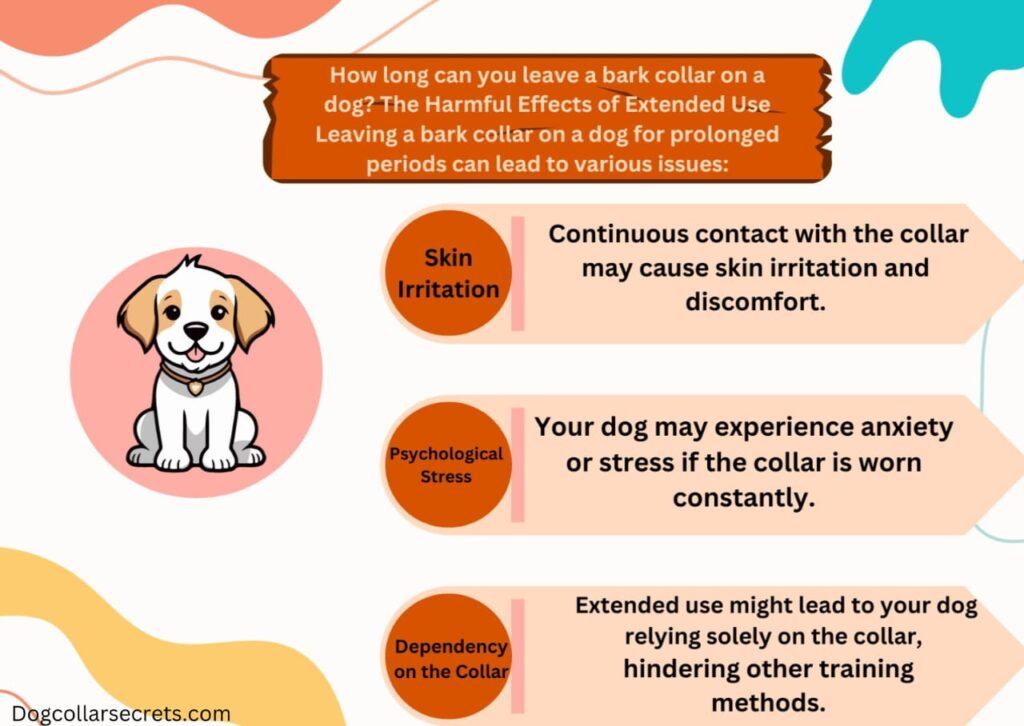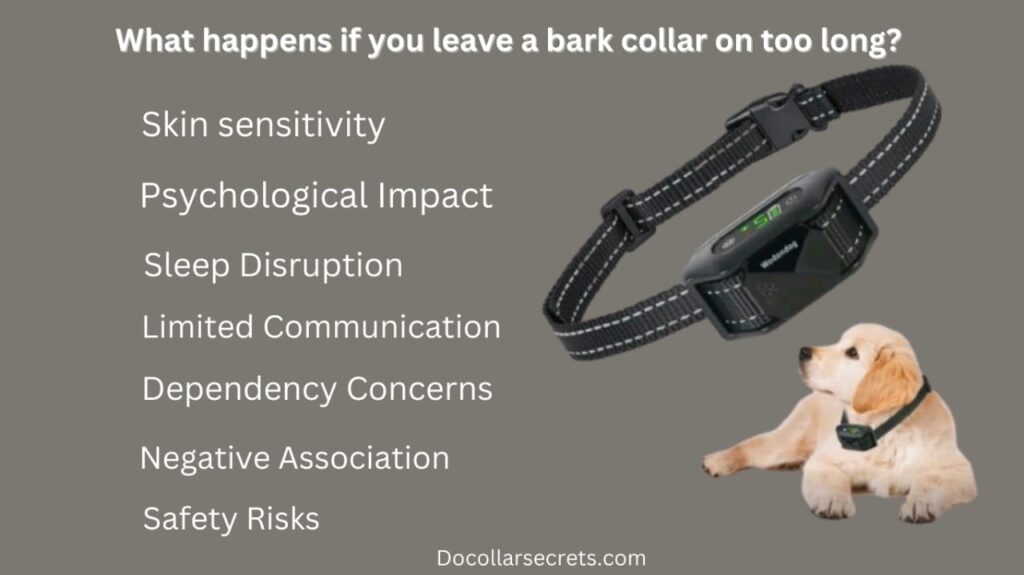How long can you leave a bark collar on a dog?

How long can you leave a bark collar on a dog?
Bark collars are training devices designed to curb excessive barking in dogs. By emitting a sound, vibration, or mild static stimulation, these devices encourage dogs to reduce their barking. Using bark collars responsibly is an effective way to teach dogs to bark less and improve their behavior, but extended use may be harmful and uncomfortable for the dog.
If you’re wondering, “How long can you leave a bark collar on a dog?” – it’s imperative that you use this training tool responsibly. The recommended duration to keep a bark collar on your dog is 8-12 hours a day. Leaving it on for more extended periods can cause discomfort, skin irritation, and unnecessary stress.
Determining the appropriate age for a dog to wear a bark collar depends on several factors, including the dog’s breed, temperament, and individual behavior. Bark collars are commonly used to address excessive barking, which can be a concern for both the dog owner and the surrounding community.
Generally, it is recommended to wait until a dog is at least 6 months old before introducing a bark collar. By this age, most dogs have completed their early developmental stages and have better adapted to their surroundings.

A bark collar is a valuable tool to address excessive barking in dogs, but responsible usage is crucial for your pet’s well-being. Let’s explore how long you can safely leave a bark collar on your furry companion and the potential risks of extended usage.
- Ideal Duration: You should keep a bark collar on your dog between 8 and 12 hours a day. This duration strikes a balance between effective training and your dog’s comfort. Remember, moderation is key to avoiding any negative impact on your pet.
If you’re looking to purchase the best bark collar for your dog, it’s a good idea to check out this article. 6 Best Anti-Bark Collars For Large Dogs 2023. It can provide valuable insights and guidance to help you make an informed decision when buying a bark collar for your furry friend. Selecting the right bark collar for your dog’s needs and ensuring it’s used properly is important for their comfort and effective training.
Can I leave a bark collar on my dog all the time?
When it comes to using a dog bark collar, also known as an anti-bark collar or simply a bark collar, it’s important to remember that these collars should not be left on your dog all the time. To ensure the well-being of your furry friend, avoid keeping the bark collar on for more than 12 hours each day. This helps prevent any potential discomfort or irritation.
For your dog’s comfort and safety, consider repositioning the bark collar on their neck every 1 to 2 hours if possible. This can prevent any undue pressure and ensure that your dog doesn’t experience discomfort.
Additionally, always check the fit of the bark collar to ensure it’s snug but not too tight. You should be able to fit two fingers comfortably between the collar and your dog’s neck. Following the manufacturer’s instructions in the manual that comes with the collar is essential to ensure its proper use.
While a dog bark collar can be a helpful tool in curbing excessive barking, it should be used responsibly. Avoid extended use, reposition the collar for comfort, and adhere to the collar’s manual for guidance on fit and usage. Your dog’s well-being should always be the top priority when using such training devices.

Can you leave a bark collar on all night?
Leaving a bark collar on your dog all night may not be advisable due to the potential risks and discomfort it could cause. A bark collar can reduce excessive barking, but it should be used responsibly. Prolonged use, especially during sleep, can lead to skin irritation, psychological stress, and dependency on the collar. Follow the recommended guidelines and limit the collar’s wear to 8-12 hours a day to ensure your pet’s well-being.
Always supervise your dog while wearing the collar, and consider providing collar-free breaks during the night to allow your furry friend to rest comfortably. Prioritize positive reinforcement training methods alongside the bark collar to achieve effective results without compromising your dog’s comfort. Consulting a professional trainer or veterinarian can provide valuable insights for a successful and safe training approach.
What are the long term effects of a bark collar?
Using a dog bark collar, also known as an anti-bark collar, can be an effective tool for training your furry friend, but it’s essential to consider the potential long-term effects to ensure your pet’s well-being.
One potential long-term effect of using a bark collar improperly or excessively is the development of negative associations or anxiety in your dog. If the collar administers corrections too frequently or with excessive force, your dog may become fearful or anxious, associating discomfort or pain with their surroundings or other dogs.
In some cases, a dog’s natural communication and warning signals may be suppressed by prolonged bark collar usage. This can lead to issues with your dog’s ability to express themselves, causing frustration or even behavior problems.
Moreover, if a bark collar is left on your dog for extended periods, it can cause skin irritation and discomfort due to constant pressure or friction. This can result in physical discomfort and potential health issues for your pet.
To minimize the long-term effects of a bark collar, use it as a training aid rather than a permanent accessory. Avoid leaving the collar on your dog for more than 12 hours a day, reposition it regularly, and ensure it fits comfortably. Follow the manufacturer’s instructions in the manual for proper use. It’s important to prioritize your dog’s comfort, well-being, and overall emotional health when using a bark collar.

What happens if you leave a bark collar on too long?
So, let’s find out What happens if you leave a bark collar on too long? Or all night.
- Skin Sensitivity: Continuous wearing of the collar can lead to skin irritation and discomfort, especially if worn for extended periods like during the night.
- Psychological Impact: Dogs may experience increased stress and anxiety if the collar is activated frequently during the night, affecting their mental well-being.
- Sleep Disruption: The collar’s activation can disrupt your dog’s sleep, leading to restlessness and potential sleep deprivation.
- Limited Communication: Barking is a natural way for dogs to communicate. Restricting it throughout the night may hinder their ability to express their needs and emotions.
- Dependency Concerns: Prolonged collar use may create a dependency on the device, making it challenging for your dog to learn alternative ways of behavior control.
- Negative Association: If the collar causes discomfort for an extended period, your dog may develop a negative association with the device, affecting their overall training experience.
- Safety Risks: Leaving any electronic device on a dog unsupervised overnight poses potential safety risks, such as getting entangled or accidentally activating the collar inappropriately.

Do bark collars hurt dogs?
You may also like this: Is A Shock Collar Bad For Dogs?
It is true that bark collars can cause discomfort to dogs when activated, but their purpose is not to harm them. The level of discomfort varies based on the type of collar and settings. Some collars emit sounds or vibrations, while others may deliver mild static stimulation. It is possible to stop excessive barking without causing pain by using these sensations responsibly and in moderation.
It’s essential to choose a collar that fits properly and to follow the manufacturer’s guidelines to ensure your dog’s safety and comfort. Consult a professional dog trainer or veterinarian to select the most suitable collar for your pet’s needs. Always prioritize positive reinforcement training methods alongside the collar to create a conducive and effective learning environment for your furry companion.
While using a bark collar, if you keep these points in mind, it will never cause harm to your dog.
- How Long Can You Leave a Bark Collar on a Dog? – A Guide to Safe Usage
- Choosing the Right Bark Collar for Your Dog’s Needs – Tips and Considerations
- Effective Bark Collar Training Techniques – Balancing Training and Comfort
- Understanding Bark Collar Sensitivity Settings – Customizing for Your Dog
- Supervising Your Dog with a Bark Collar – Ensuring Safety and Positive Results
- Introducing a Bark Collar to Your Dog – Gradual Adaptation for Success
- Monitoring Your Dog’s Reaction to the Bark Collar – Signs of Comfort and Discomfort
- Complementing Bark Collars with Positive Reinforcement – A Holistic Training Approach
- When to Use and Remove the Bark Collar – Appropriate Situations and Rest Periods
- Consulting a Professional Trainer or Veterinarian – Expert Advice for Bark Collar Usage

What are the side effects of a bark collar?
The use of bark collars, designed to curb excessive barking in dogs, can have potential side effects on their well-being. One concern is the aversive consequences these collars may impart, leading to negative behavioral outcomes. When dogs experience discomfort or stress from the collar’s correction, it can result in apathy, anxiety, or even aggression. Rather than addressing the barking issue, prolonged exposure to aversive consequences might create additional behavioral problems, turning a happy and confident dog into one that is anxious or aggressive.
Skin irritation is another common side effect of bark collars. The contact points on the collar, typically delivering static corrections, may cause irritation and discomfort on the dog’s skin. Prolonged use without breaks can exacerbate this issue, potentially leading to more serious skin problems. It’s important to regularly check your dog’s neck for any signs of irritation and provide sufficient time without the collar to allow the skin to recover.
Moreover, there’s a risk of the dog associating the aversive stimulus with the wrong behavior. If the collar is not used precisely during instances of excessive barking, the dog might link the correction to unrelated actions or environmental factors. This misassociation can confuse the dog and hinder the effectiveness of the training, possibly leading to unintended consequences in their behavior. Always monitor your dog closely and use bark collars judiciously to mitigate these potential side effects.
Conclusion
The main question we explored in this article was, “How long can you leave a bark collar on a dog?” We learned that responsible usage is crucial when come, employing bark collars as training devices for our beloved canine companions. Although the collars can reduce excessive barking, they can also cause discomfort to our dogs if worn for long periods of time.
Based on our findings, the recommended duration to keep a bark collar on a dog is 8 to 12 hours a day. This timeframe strikes a balance between practical training and ensuring the well-being of our pets. In order to avoid skin irritation and unnecessary stress to our dogs, we must supervise them while they wear the collar and provide collar-free breaks.
By following the guidelines in this article, we can create a safe and positive training environment for our dogs. You should use bark collars along with positive reinforcement methods. Consult a professional dog trainer or veterinarian for further guidance. With responsible usage, we can help our furry friends learn and grow while fostering a strong bond built on trust and understanding.
Bark collars can yield immediate results for certain dogs, especially those sensitive to the collar’s corrections. When the dog barks, the collar gives a small warning to stop the barking. But it depends on the dog’s personality, why they bark too much, and the type of collar used. Some dogs might respond quickly, while others could get used to the collar and not be affected after a while.

Also visit this: How To Stop Dog Barking Without Shock Collar?
Will A Bark Collar Teach My Dog To Stop Barking?
What Age Can You Use A Bark Collar On A Dog?
FAQ
Are bark collars good or bad for dogs?
Bark collars can be controversial, as their impact on dogs varies based on individual temperament and training methods. Some argue they can be effective for excessive barking when used properly, while others believe they may cause fear or anxiety in dogs. It's essential to consider alternative, positive training techniques before resorting to bark collars.
What are the disadvantages of a bark collar?
Bark collars can harmful effects on dogs, as they may induce fear and anxiety due to aversive stimuli. It can lead to behavioral problems and a decline their overall happiness and comfort. Additionally, such collars might not address the root cause of excessive barking, only suppressing the symptom without resolving the underlying issue. It is essential to consider alternative, positive training methods that prioritize the well-being of the dog.
Do vets recommend bark collars?
The opinion among vets regarding bark collars is divide. Some vets may recommend them as a last resort for specific cases of excessive barking where other training methods have failed. However, many veterinarians prefer positive reinforcement training techniques and behavioral modification over aversive tools like bark collars. They advocate for addressing the root cause of the barking behavior and ensuring the well-being of the dog during the training process.
Do bark collars work immediately?
Bark collars can yield immediate results for certain dogs, especially those who are sensitive to the collar's corrections. When the dog barks, the collar gives a small warning to stop the barking. But it depends on the dog's personality, why they bark too much, and the type of collar used. Some dogs might respond quickly, while others could get used to the collar and not be affected after a while.





